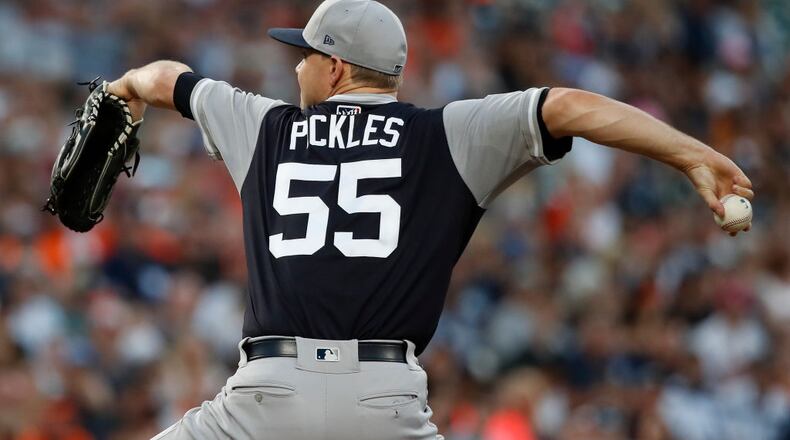>>RELATED: Gray happy to be heading to Cincinnati
“I think it started before, but at the winter meetings were when I had a decent amount of exchanges with (Yankees general manager Brian) Cashman in terms of ideas,” Reds president of baseball operations Dick Williams said after the trade was announced. “And then that went away for a while, but it came back around.”
In the time between the beginning of talks about Gray and the actual consummation of the deal, the Reds acquired right-handed starter Tanner Roark from the Washington Nationals and left-handed starter Alex Wood (along with several other players) from the Los Angeles Dodgers.
The Roark deal was done Dec. 12 while the winter meetings were still going on, and the Wood acquisition took place roughly a week later.
» RELATED: Reds pitchers eager to work with new coach
Though they never announced it publicly, Williams said the Reds went into the offseason aiming to add three starters to a staff that allowed the most hits, runs and home runs in the National League last season.
They ended up doing so without giving up much in terms of premium talent that is anywhere near reaching the majors, and comparing the numbers of the new guys to the Reds’ 2018 starters shows how the brass could improve the rotation for 2019 without doing anything drastic.
None of the new Reds starters had outstanding numbers last season, but they all would have been among Cincinnati’s top five starters — easily.
Wood’s 3.68 ERA would have led the team by more than half a run while his 151.2 innings pitched and 135 strikeouts would have ranked second (behind Luis Castillo in each case).
His 1.3 WAR (Wins Above Replacement, which measures overall numbers against the “average” player in the league at each position) would have also been second among starters only to Castillo, who’s WAR was 1.6.
Roark pitched 180.1 innings, more than Castillo’s team-leading 169.2, and Roark’s 146 strikeouts would have trailed only Castillo’s 165.
While Castillo’s team-best 4.30 ERA nips Roark’s 4.34 mark, Roark’s WAR of 3.0 would easily have been the best among Reds starters last season.
Gray had a down year, but the now-29-year-old righy’s 4.90 ERA, 123 strikeouts and 57 walks in 130.2 innings still would have put him in the discussion as the Reds’ No. 3 starter in 2018.
Sonny Gray on joining #Reds: ‘It just feels right for me’ https://t.co/KeHTzGazlC @DavidPJablonski pic.twitter.com/hin3QzUjwG
— journalnews (@journalnews) January 23, 2019
“Our primary goal this offseason was to address starting pitching, and we feel we’ve made some very good strides in that direction,” Williams said from Goodyear, Ariz. where pitchers and catchers are set to report Feb. 13 for spring training.
While Wood and Roark are set to be free agents at the conclusion of the 2019 season, Gray signed a three-year contract extension with a club option that could keep in in a Reds uniform through the 2023 season.
“We had him on a short list of guys we were interested in talking to,” Williams said of Gray, a first-round draft pick who was an All-Star in 2015 when he went 14-7 with a 2.73 ERA for the Oakland A’s. “And once we had the two guys with the one-year deals, we said we would only acquire Sonny if we were able to extend him. That was a condition of pursuing this trade.”
» HAL McCOY: Brennaman pulled no punches on the air
The acquisition of three veterans signals not only an urgency to end a four-year streak of last-place finishes but also a change in philosophies when it comes to building a starting staff.
After leaning mostly on a large-but-untested stable of starters the last two seasons blew up in their face, the Reds front office has given new manager David Bell three experienced pros to build around.
In so doing, they may be hoping to replicate the success of signing Jared Hughes and David Hernandez, veterans who not only posted strong numbers after signing with the Reds as free agents last year but provided some stability as up-and-comers Raisel Iglesias, Amir Garrett and Michael Lorenzen settled into their own niches.
Bell and new pitching coach Derek Johnson might only need to fill one spot in the rotation this spring, but they will have no shortage of options.
A half-dozen or so players who have had a shot over the past two plus seasons but failed to hold onto a rotation spot remain on the 40-man roster.
While some have had trouble staying healthy (Anthony DeSclafani, Brandon Finnegan), lack of consistency (Tyler Mahle, Sal Romano, Cody Reed, Robert Stephenson) has more often been the issue.
If nothing else, lack of competition no longer will be one.
About the Author

